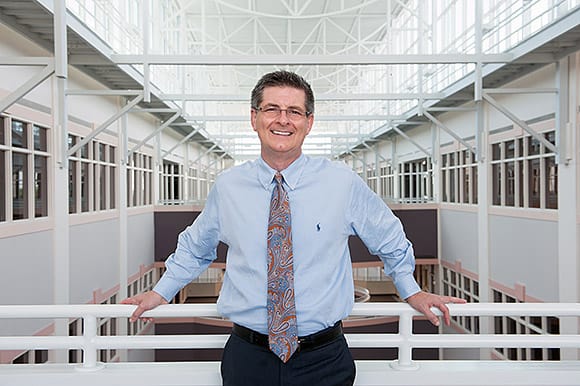
Dan Wyant
On June 2, the U.S. Environmental Protection Agency issued a new proposed rule under the Clean Air Act that will regulate carbon emissions from new and existing power plants. The rules require states to reduce their overall carbon emissions to 30 percent below 2005 levels by 2030. Targets for carbon reduction vary by state based on a formula that takes into account recent emissions, a state’s ability to shift to natural gas as a fuel for power plants, and expected retirements of coal-fired power plants. States can determine how they will meet their requirements, and have until June 30, 2016, to submit plans.
Because it falls under the Clean Air Act, Michigan’s response to the law will be led by the Michigan Department of Environmental Quality. Bright Ideas recently spoke with Dan Wyant, director of the MDEQ, on how the agency will coordinate the state’s response to these new rules.
The following interview is lightly edited for clarity.
According to a recent article in Governing, Michigan is about in the middle of the pack with respect to the amount of carbon emissions it must reduce to reach the new EPA targets (about 31.3 percent to reach the goal of 30 percent below 2005 levels). Can you tell us a little about your thoughts on the strategy you think is best for Michigan to meet these new requirements?
First, we need to understand what is being asked of us. Yesterday, I assigned full-time Vinson Hellwig, who leads our Air Quality Division. He will work on this issue on a full-time basis and he is uniquely qualified, with tremendous expertise in working with the EPA on air quality issues as a private consultant. And he has a background in energy, too.
I have assigned Vince to read the rule, and then we will work with the governor’s office, the Michigan Public Service Commission and the Michigan Economic Development Corporation because this policy intersects with energy policy pretty quickly.
So, first we need to do our homework, and understand what we are being asked to do per the rule. Then, we need to get a support team around it so that we can look at Michigan’s current energy use, our current actions and, from that, start to fashion some strategies and recommendations going forward.
Is it fair to say that it is premature to discuss specific strategies that you might be considering?
It is. Everything is on the table; we haven’t pulled anything off. The big questions we are getting asked are the ones we can’t answer today: How are you going to do this? Are you going to be able to meet that deadline? What will be your specific strategy?
I need to say it directly: We just don’t know.
Michigan has somewhat of a measured response to this. Most states are either all-in or all-opposed, meaning they say either this is a great thing to do or this is going to really jeopardize our economy. In Michigan, we say it both ways. The Governor has already laid out a series of energy goals, which include eliminating energy waste and increasing renewable fuels in our mix. If we accomplish those, we may not have to do more to satisfy EPA. But we are not going to let Michigan’s energy policy be dictated by the EPA, and we continue to think we have to balance reliability and affordability with protection of the environment when we look at questions like these.
So, taking the approach embodied in our governor’s culture, to make sure we have all of the facts. We have until October to comment on the rule as to what we like and don’t like. And from that, the EPA has about a year to get the rule in place. And then we have a year to fashion Michigan’s plan. So this is a process, and it is going to take some time.
Energy efficiency has been demonstrated in study after study to be the most cost-efficient and effective method for reducing carbon emissions. What role do you believe energy efficiency should play in Michigan’s carbon-reduction strategy? What methods have been effective so far in promoting adoption of energy efficiency?
To me, it is obvious that there are a lot of reasons to want to eliminate energy waste – whether you are worried about carbon or worried about energy costs. My sense of it is, yes, energy efficiency will play a significant role in the strategy. To what degree exactly and in what amounts, I can’t say yet. But energy efficiency clearly provides a lot of opportunity, is efficient and, I think, there is a lot more to be done there. So clearly it will be one of the first options we look at.
In a recent Michigan Radio interview, you noted that Michigan utilities are moving away from coal faster than their counterparts in surrounding states. Data from the Energy Information Administration show that a large amount of this shift has been towards natural gas, and we know natural gas prices may go up. What kind of energy mix do you believe Michigan needs to focus on going forward to support both carbon targets and economic development?
I do not have a strong opinion about the exact mix that Michigan will have. I will say, in talking to utilities and observing where Michigan is, that we both started with and are moving more quickly than surrounding states to a more diversified portfolio.
You’ve been quoted in multiple media sources emphasizing the need for flexibility in implementing the new carbon standards, especially considering the makeup of Michigan’s economy and our need for reliable, affordable energy to fuel our manufacturing industry. Can you give some examples of the kinds of flexibility you believe Michigan needs to address these new requirements while growing our economy?
There are two broad categories. One is the energy mix — that we be allowed to have maximum flexibility in the mix and options to meet the reduction target. I think if greenhouse gas reductions targets are prescribed per facility, as opposed to a statewide target, that is too restrictive. And so flexibility would mean giving us a target and letting us determine how to meet it — and, if we meet it, call it good.
The other would be timing. We want to stage this so that we recognize that this is a transition. Michigan can work towards meeting federal mandates, but we will need an appropriate amount of time to get there. I have to look at this more closely to know whether we are being given adequate transition time. Because if we do this too fast, too hard, it will be a real issue for reliability and it may be a standard that we just can’t meet because of timing.
What are some of the first orders of business for Mr. Hellwig as he undertakes this task on the EPA rules?
He will have to do some things simultaneously. He is going to go through the 645 pages of the rule. He will then have a support staff within the MDEQ and work with other state agencies, like the MPSC, which is dealing with federal mandates of its own. He will take a look at Michigan’s numbers — where we were in 2005, where we were in 2012 and what is the formula the EPA is using. He’ll look at where we have made progress and where there is opportunity.
From this, essentially, we will fashion the options. And so his charge will be to work with an internal team to do the homework, cull the data and get the analysis done. From that, we will, in fairly short order, move to a stakeholder process where we have conversations with interested and affected stakeholders, and understand how this rule fits in the ongoing discussions regarding energy policy. Because we can’t do this, nor should we do this, in a vacuum.
So we will spend time understanding exactly what the task is, what the requirement is and how much time we have to meet the targets. So we will take that forward with a series of options to our respective stakeholders, and we’ll be sure our options fit within the larger picture of making sure Michigan has a “no regrets” energy policy.
Who are the stakeholders that you will be engaging in this process?
Those stakeholders will include broad categories – some of which overlap. There will be environmental conservation groups, utilities, and ratepayers – both businesses and residential consumers. In other words, everyone in Michigan is potentially impacted, and we have a responsibility to have conversations with people representing all those perspectives. Those conversations will happen yet this year; we want to have conversations prior to (the state giving comments to the EPA), so I think we will have some level of stakeholder involvement before we go to final comments. Of course, a lot of these groups are already meeting to discuss energy policy, so we also want to make sure we aren’t duplicating efforts.
Leaders in neighboring states have expressed concern that the new targets will have a detrimental effect on jobs. Is there a flip side to this view; could these new rules spur economic development? Within the four building blocks proposed in the rules (increasing coal plant efficiency, increasing gas utilization, increasing renewables and other clean energy resources and increasing demand-side energy efficiency), which do you believe may hold the greatest potential for building up Michigan’s economy?
I think it will cut both ways. I believe there is the potential, if not done right, for our costs to rise and to put us in a competitively disadvantaged situation. So, if we don’t do this right, I do fear that it will put us in a noncompetitive situation. But if done right, the fact that Michigan has been a leader in diversifying our energy resources could turn into a real competitive advantage for us.
I think in fairness, we have to say it both ways, because I think both are true. When you get arguments on both sides, I tend to believe they are both valid. And then people ask what side do I come down on? And I am in the position to say I think the environmental benefit, if done with proper flexibility and enough transition time so that we don’t negatively impact the economy by lowering greenhouse gas over time, is a good thing.


